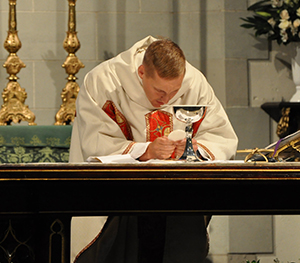In seminary, I was taught that even congregations and denominations that do not consider themselves "liturgical churches" still have patterns and customs for worship that over time become normative. They are in their own way rituals, or performance. Worship is performance, not in the sense of entertainment, but rather as the way a worshiping community enacts the theological, relational, and cultural values that are foundational to its identity. From week to week, we see a congregation perform an established repertoire of acts, gestures, and statements that say, "this is who we are."
Growing up as a young Jewish kid at Congregation Kol Ami, I came to know and anticipate every core gesture and to blend in with the rhythm and pacing of every practiced word. But I also noticed the places in the service where there was untidiness, even dissonance. The fact that Judith Sobel sang theAlenu an octave higher than everyone else--and not always on key--and that some people bent their knees and bowed at the designated place in that prayer, and some didn't, were also part of the congregation's identity. Every congregation, no matter how uniform it may look from the outside, is diverse: diverse pieties, spiritualities, theologies, and ritual sensibilities. In Episcopal congregations, for example, at the invocation of the Holy Trinity, some people will make the sign of the cross, or bow, or do nothing at all. In some parishes, certain people will kneel during the Eucharistic Prayer, while others will stand. Some adore "bells and smells," while others would prefer it simple and unadorned. And you may find all of this diversity within one congregation.
From the priest's perspective--at least, this priest's perspective--the challenge is to acknowledge and respect this diversity. In every service, the priest hopes that each person will find something that will spirituality nourish him or her. Perhaps it will be the sermon, or the hymns, or the language we use to talk about God. The ritual actions likewise may resonate with one person, and not another, for theological, aesthetic or cultural reasons. And, perhaps unexpectedly, the congregation's diversity also includes the priest. Like the congregation, the priest is a worshiper who brings his or her theology, relationship with God, personality, and ritual sensibilities to the altar. Anglicanism has always striven for unity without uniformity, and I would add, communion without conformity. Ritual should, therefore, make a generous space for "a bit of me" and "a bit of you." At its best, worship will enable both priest and every member of the congregation to bring something of their authentic selves to their shared encounter with God.
Abundant blessings,
Fr. Ethan+




No comments:
Post a Comment